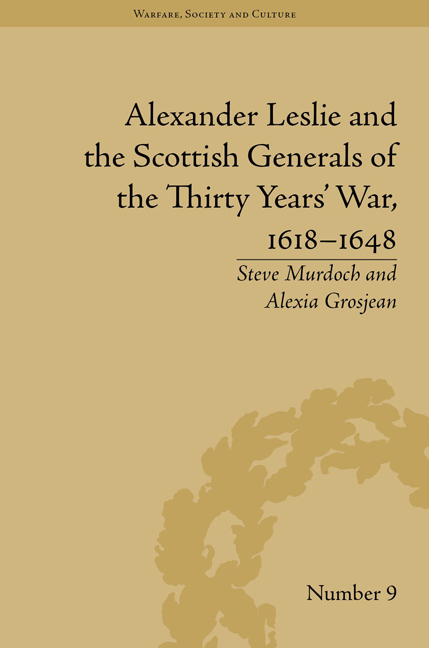Book contents
- Frontmatter
- CONTENTS
- Dedication
- Acknowledgements
- Abbreviations
- Stylistic Conventions
- Introduction
- 1 Scotland's Indigenous Military Cultures
- 2 The Scottish Military Diaspora
- 3 The Thirty Years' War Campaigns: Stralsund to Prague, 1628–35
- 4 Alexander Leslie and the Army of the Weser, 1635–9
- 5 The Home Front: Leslie, Ruthven and the Bishops' Wars, 1638–41
- 6 The Scottish ‘Veteran Generals’ in England, 1642–7
- 7 Going Full Circle: The New Scottish Command in Europe, 1639–48
- Conclusion
- Appendix
- Notes
- Works Cited
- Index
3 - The Thirty Years' War Campaigns: Stralsund to Prague, 1628–35
- Frontmatter
- CONTENTS
- Dedication
- Acknowledgements
- Abbreviations
- Stylistic Conventions
- Introduction
- 1 Scotland's Indigenous Military Cultures
- 2 The Scottish Military Diaspora
- 3 The Thirty Years' War Campaigns: Stralsund to Prague, 1628–35
- 4 Alexander Leslie and the Army of the Weser, 1635–9
- 5 The Home Front: Leslie, Ruthven and the Bishops' Wars, 1638–41
- 6 The Scottish ‘Veteran Generals’ in England, 1642–7
- 7 Going Full Circle: The New Scottish Command in Europe, 1639–48
- Conclusion
- Appendix
- Notes
- Works Cited
- Index
Summary
The invincible King of Sweden, who provided [Stralsund] an able Governour in their greatest neede, to wit, Sr Alexander Lesly, who immediately after his entry tooke the command upon him, keeping both the Dane, their Souldiers, and the Burgars under his command
Christian IV of Denmark-Norway found himself in a disastrous military predicament by the spring of 1628. He had rashly decided to attack the empire without either fully consulting his allies or completing any kind of negotiation with his Swedish neighbour for mutual support. A confluence of circumstances altered this situation. At the time there was a prevailing belief that Stralsund's neutrality would not be respected by the Habsburgs. This resulted in frenetic Danish endeavours to bolster the Stralsund garrison, one of the last remaining allies they had. After all, the neighbouring duchy of Pomerania had yielded to the forces of the Holy Roman Empire after Albrecht von Wallenstein ordered the occupation of all ports and towns in October 1627. This forced Duke Bogislaw XIV to sign the Capitulation of Franzburg on 10 November. Wallenstein thereafter sought to secure the southern coastline of the Baltic Sea for Ferdinand II and establish a naval base from which the Imperialists could undertake operations against Denmark. Indeed, from then on Wallenstein revelled in his self-proclaimed title of ‘General of the Oceans and the Baltic Sea’. Stralsund, however, ignored Bogislaw's order to adhere to the capitulation and instead turned first to Denmark and then to Sweden for support.
- Type
- Chapter
- Information
- Publisher: Pickering & ChattoFirst published in: 2014



